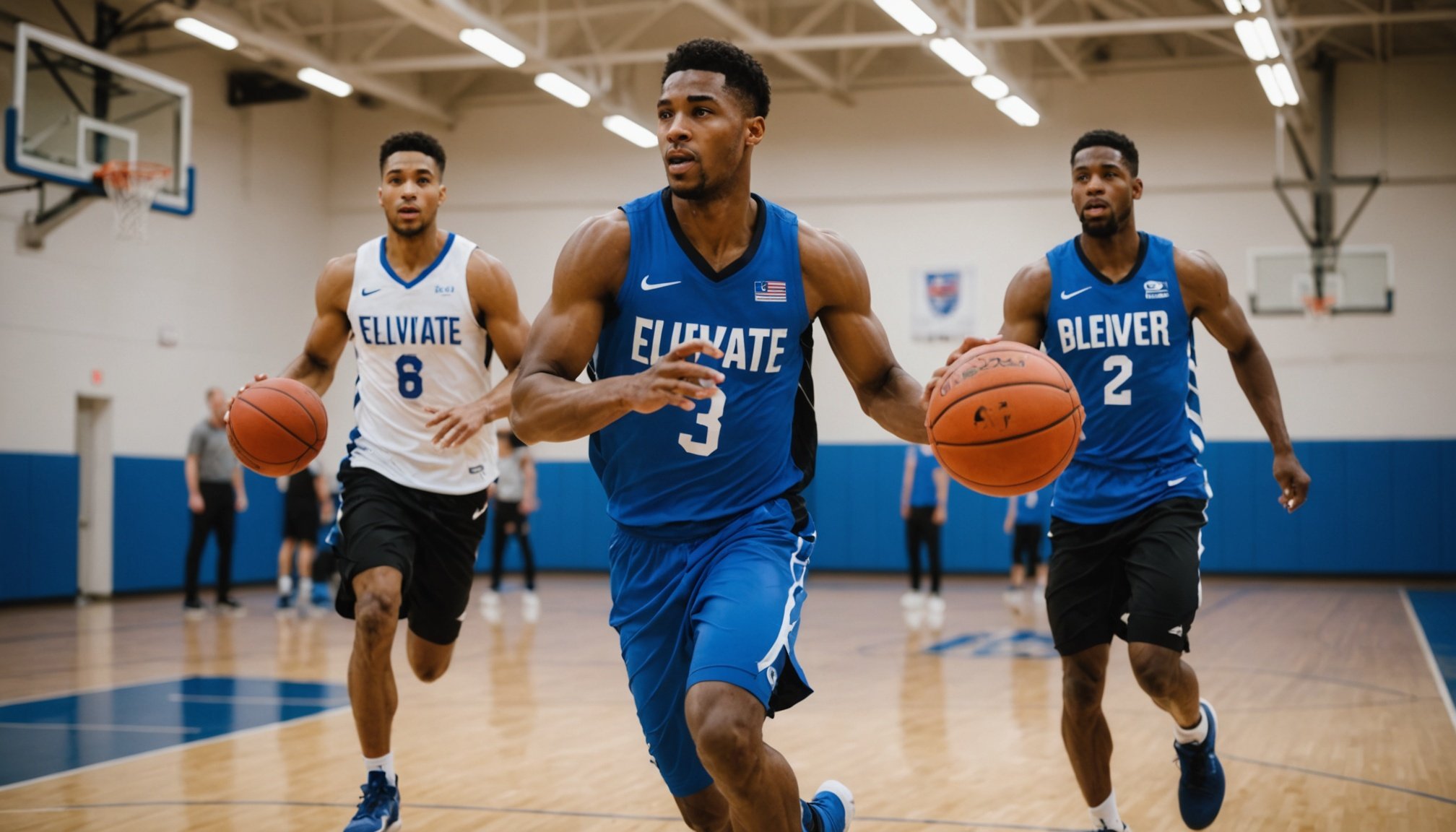Importance of Cardiovascular Fitness in Basketball
Cardiovascular fitness is crucial for maximizing basketball performance. It enhances a player’s ability to maintain peak activity levels during games and practice sessions, crucial for UK athletes aiming for excellence. By improving cardiovascular endurance, athletes can sustain high-intensity activities, essential for maintaining agility and outpacing opponents on the court.
Enhanced cardiovascular health boosts oxygen delivery to muscles, allowing players to recover more quickly after sprints, facilitating better overall performance. Additionally, robust cardiovascular fitness can significantly aid in injury prevention. By building heart and lung efficiency, athletes reduce strain during high-demand plays, lowering the risk of strains or sprains.
Also to read : Boosting game performance: leveraging technology to empower uk basketball athletes in tracking and improvement
For basketball players, cardiovascular fitness translates into quicker recovery between plays and less fatigue during critical game moments. This allows for sharper focus and improved decision-making under pressure. Incorporating consistent cardiovascular training routines can yield remarkable benefits, encouraging UK athletes to develop and maintain a steady regimen. The connection between cardiovascular health and enhanced basketball performance is evident. Emphasizing this fitness component empowers players with the stamina required to excel, making it indispensable for any comprehensive training program.
Understanding Interval Training
Interval training is a powerful tool in enhancing athletes’ performance, especially in sports requiring bursts of energy like basketball. Defined as high-intensity workouts alternated with periods of rest or low-intensity activity, this training methodology builds endurance and boosts overall fitness. For UK athletes, such methods are invaluable in improving their on-court stamina and agility.
In the same genre : Skyrocket your performance: enhance endurance through proven interval training strategies for basketball players in the uk
When incorporating interval training into basketball conditioning, specific types prove particularly effective. Sprint intervals mimic the stop-and-start nature of gameplay, enhancing explosive speed and swift recovery. High-intensity circuit training, combining cardio and strength exercises, benefits total body conditioning, which is vital for a sport that demands both power and endurance.
Comparatively, steady-state cardio involves maintaining a consistent pace and does not offer the same benefits. Interval training prepares players for the dynamic and unpredictable nature of basketball, where agility and speed are critical. Moreover, these workouts ensure athletes experience diverse stimuli, preventing plateaus and maintaining enthusiasm. As such, they are often preferred by coaches aiming for noticeable performance improvement. Interval training’s adaptability makes it suitable for various player skill levels, ensuring targeted outcomes for fitness enhancement.
H2 – Effective Interval Training Techniques for Basketball
Integrating high-intensity interval training techniques into basketball routines can significantly elevate a player’s agility and fitness improvement. Primarily, the focus should include sprint intervals, which replicate the quick bursts needed during gameplay. These involve alternating between periods of maximum effort and recovery, thereby enhancing speed and anaerobic capacity.
H3 – Sprint Intervals
Sprint intervals can be seamlessly incorporated into a training regimen by dedicating short segments, like 30-second sprints followed by equal rest periods. This not only mimics the sporadic intensity of a basketball game but fundamentally improves cardiovascular endurance.
H3 – Circuit Training
Incorporating circuit training involves combining cardio with strength exercises, allowing athletes to work on both explosiveness and endurance. A well-rounded circuit could include jumping jacks, burpees, and push-ups in swift succession to challenge the body comprehensively.
H3 – Fartlek Training
Fartlek training, translating to “speed play” in Swedish, introduces an element of unpredictability, vital for basketball’s dynamic nature. Players alternate their speed and intensity randomly during runs, reflecting real-game scenarios where athletes must adapt suddenly. This technique boosts stamina and strategic movement, crucial for game-time effectiveness.
Sample Workout Plans for UK Basketball Players
Developing effective workout plans tailored for UK basketball players involves strategic incorporation of interval workouts to boost performance. Maintaining a balanced training schedule that challenges athletes while allowing for adequate rest is essential. Here’s a detailed week-long plan emphasizing training schedules to enhance both skill and fitness levels:
- Monday: Begin with 30-second sprint intervals on the court, followed by equal rest periods. This can strengthen explosive speed.
- Tuesday: Engage in high-intensity circuit training combining agility drills with strength exercises such as push-ups and burpees.
- Wednesday: Active recovery day with light swimming or yoga to promote flexibility and relaxation.
- Thursday: Incorporate Fartlek running sessions creating unpredictability and emulating game scenarios.
- Friday: Strength training focused on lower body; include exercises like squats and lunges, vital for court endurance.
- Saturday: Review and refine shooting techniques through dedicated practice sessions.
- Sunday: Rest to allow muscles to recover and prevent overtraining.
Each session can be adjusted, ensuring suitability for various skill sets while incorporating necessary rest and recovery, crucial for optimal player performance.
Expert Advice on Enhancing Performance through Fitness
Insights from seasoned basketball coaches and fitness trainers reveal impactful tips for optimizing basketball performance through high-intensity interval training. They emphasize integrating short, explosive bursts within workouts to mirror game dynamics. This method heightens stamina and sharpens agility on the court.
Nutrition is paramount in supporting cardiovascular fitness. Trainers advocate for balanced meals rich in proteins, carbohydrates, and essential fats, facilitating muscle recovery and peak energy levels. Adequate hydration before, during, and after workouts ensures athletes maintain endurance and concentration.
Recovery is crucial in enhancing overall fitness. Incorporating techniques like stretching, foam rolling, and proper sleep patterns can dramatically boost recovery rates. This not only aids in preventing injuries but also increases muscle resilience.
Inspiring case studies highlight UK basketball players transforming their game through these strategies. Athletes report improved endurance and faster decision-making under pressure, crediting interval training for these advancements. Trustworthy guidance from experts ensures players tackle competitions with confidence and vitality, ultimately fostering a competitive edge.
By prioritizing these educational insights, athletes can adopt tailored approaches to achieve optimal fitness and outstanding game performance.
Practical Applications of Interval Training in Basketball
Transitioning results from interval training to on-court performance is pivotal for basketball success. Players who incorporate specific high-intensity workouts can harness improved stamina and agility, directly enhancing their game performance. These workouts encourage UK athletes to maintain energy efficiency and explosive power throughout a match.
Adapting training applications to align with the basketball season ensures players remain prepared while avoiding overexertion. During peak game periods, adjustments such as focusing on shorter, sharper interval bursts can help preserve energy reserves. Conversely, off-peak adjustments might involve progressively extended intervals to build endurance.
Monitoring progress is essential for effective skill enhancement. By tracking metrics such as heart rate and recovery times during training, athletes gain insights into their fitness trajectory. Utilizing tools like wearable tech can facilitate precise measurement, allowing tailored tweaks to individual training schedules.
To maximize benefits, players should engage with their coaches, integrating feedback into their routines. Ultimately, the practical application of well-defined interval training regimes empowers basketball athletes with the stamina and agility required for competitive success.











